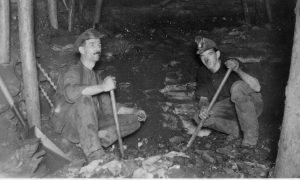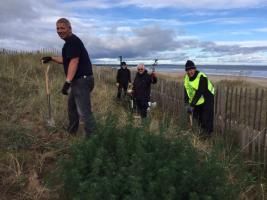Speaker - John McManus - Coal Mining in the East Neuk of Fife
Tue, Jul 18th 2017 at 7:00 pm - 8:30 pm

President John Spittal and member George McIntosh gave details of the forthcoming “St Andrews Got Talent” contest, organised by Madras College Community Use and sponsored by the Rotary Club of Kilrymont St Andrews.
Auditions will take place in Madras Kilrymont School hall on Thursday August 24 and are open to talented individuals of all ages and skills. The final is on Thursday September 7, also at Kilrymont School hall.
Singers, dancers, musicians, magicians – whatever your talents, begin rehearsing your act for the big event. Details of how to enter are on posters currently being distributed throughout the Town.
Speaker for the evening was John McManus, now retired but previously Professor of Geology at St Andrews University for 15 years. He was also a founding member of the International Association of Estuarine and Coastal Scientists.
The subject of his presentation astonished most of the membership – the history of coal mining in the East Neuk of Fife.
Like most other locals, the membership believed coal mining had been confined to South and Central Fife. Early in his address, Prof. McManus proved otherwise by screening a photograph of the Scores Cliff, only 200 yards from the Scores Hotel venue, which clearly showed a large seam of coal near the base of the cliff and the aperture which had been the mine entrance. There was evidence of at least 25 similar coal seams in the East Neuk, a number inland and others on the coast between Pittenweem and St Monans.
Old mine shafts, some as deep as 150 feet, can still be found in fields between Ceres and St Andrews and in the Peat Inn locality.
A huge seam in the Pitscottie area had to be covered over in the 17th century as a number of people and animals had perished falling into the open shafts.
Up to 150 years ago, the mining had been a family affair, with dad hewing the coal underground, the children as young as 6 years old carrying it to the ladders, and mother hauling the baskets of coal to the surface. This came to an end in 1842, when legislation banned the practice of children and women working underground.
Prof. McManus also surprised his audience with the news that St Andrews had been the first town in Scotland to use “Parrot Coal Gas” which contained gas used as a fuel, mainly to power street lighting.
Coal mining in the East Neuk had been going on for some 300 years.
Amazingly, it only came to a halt at the outbreak of World War II. Principally because most of the coal mined in this area during the 1930s had been exported to supply the German navy!
In giving a vote of thanks, Iain MacKinnon praised Prof. McManus for the fascinating content of his talk – and in addition thanked him for making members wary of wandering in local fields in case they disappeared down a disused mine shaft!
'What We Do' Main Pages:
